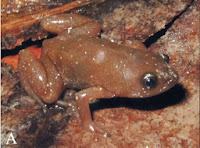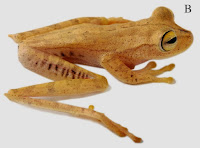Fanged Frogs of the genus Limnonectes
are found across southern China and Japan, as well as the Philippines,
Southeast Asia and much of Indonesia. They are unusual in that the males are
considerably larger than the females (the reverse of the situation found in
most Frogs), with greatly enlarged heads and powerful jaws. The name of the
group comes from the fang-like odontoid processes on the lower jaws of both
sexes. Mating behaviour seems to vary considerably within the group, with some
species giving birth to live young, while others lay eggs, sometimes in nests,
and sometimes provide parental care to nestlings. The males often lack vocal
sacs and in many species have been seen to fight over territory.
In a paper published in the journal Zootaxa on 4 November 2014, JodiRowley of the Australian Museum Research Institute, Doung Thi Thuy Li and Huy Doc
Huang of the Faculty of Biology at the University of Science-Ho Chi Minh City
and Ronald Altig of the Department of Biological Sciences at Mississippi StateUniversity, describe the mating behaviour of the Fanged Frog Limnonectes dabanus for the first time.
Males of Limnonectes dabanus
show the most extreme enlargement of the head of any species of Fanged Frog,
with a head that comprises almost half the body length. The species is found on
the Langbian Plateau in Lam Dong Province, Vietnam, and around tributaries of
the Mekong and Krong No rivers in Cambodia and southern Vietnam. The species
lives in forested areas, and its biology is not well understood.
Adult male Limnonectes dabanus. Rowley
et al. (2014).
Rowley et al. observed the
Frogs at the Nui Ong Nature Reserve in Binh Thuan Province, Vietnam, where they
were able to observe the mating, and collect specimens of the eggs and
tadpoles. Males of Limnonectes dabanus
were observed calling from beside a rivulet beneath a rock overhang, from a
drainage line in mixed forest, and at the base of a Pandanus plant in a large
but shallow temporary pond. Despite lacking vocal sacs they were able to
produce a short monotonal chirp, which sounded to human listeners like a drip
falling into water; Rowley et al. suggest
that if other species of Fanged Frogs make similar noises then this might have
been overlooked by herpetologists. One male was observed with two females in
close attendance while none of the calling males had another male nearby,
suggesting that the males secure and defend territories, mating with any female
that comes to its territory (though combat between males was not observed).
Adult female Limnonectes dabanus. Rowley
et al. (2014).
Eggs within the rock overhang territory were found on the underside
of the overhang (about 40 cm above the water surface), on the adjacent rockface
and in the water beneath the overhang (which was mostly only a few millimetres
deep). This distribution is difficult to understand, as it appears the female
Frogs were relatively unconcerned as to where their eggs were deposited. Rowley
et al. suggest that the female Frogs
may be exhibiting behaviour similar to that seen in Frogs of the genus Mixophyes, who lay eggs they kick them
onto a nearby moist surface, with some eggs subsequently falling to the floor.
Adult male, M, and female, F, in seep area beneath an
overhanging boulder with eggs on the ceiling (yellow up arrow) and floor
(yellow down arrow). Rowley et al.
(2014).
Tadpoles were collected from a muddy, leaf-litter filled pool on the
forest floor. The largest was 21.2 mm in length, with coarsely placed teeth and
an upper jaw sheath with fine serrations, and a v-shaped lower sheath. The tail
fin was clear with speckles.
Limnonectes dabanus (A) eggs grouped for photography, (B) tadpole in lateral view 21.2
mm, tail tip damaged). (C) Oral apparatus of same tadpole (stained with crystal
violet to reveal translucent structures) and (D) dorsal view of same tadpole. Rowley
et al. (2014).
See also…
Cryptic species are species that closely resemble other species, and
cannot be separated by simple, non-invasive examination. While taxonomists have
known about cryptic species for a long time, it was not...
Cryptic species are species which resemble one-another physically, and
which cannot generally be separated using traditional taxonomic
methodology, but which are nevertheless genetically and reproductively
isolated. Genetic studies of many groups of...
Many species of Amazonian Amphibians are considered to be highly
threatened due to habitat loss, with the potential for the situation to
become much worse due to climate change in the near future. This has led
to increased efforts to understand the ecology...
Follow Sciency Thoughts on Facebook.







